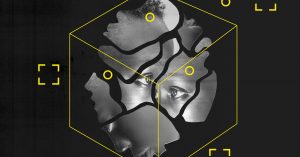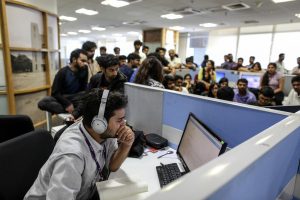Two phrases. The first: “It’s no longer a question of ‘if,’ but a matter of ‘when.'”
That was the all-caps message that flashed across the giant screens at San Jose Convention Center yesterday before Mark Zuckerberg walked onstage to kick of Oculus Connect 6. Since Facebook acquired virtual-reality company Oculus in 2014, Zuckerberg has been the one to deliver the first keynote at its developer conference.
The second: “It’ll take a little more time than I thought to get to the next generation of VR, but that just means these are going to be the good old days for longer.”
That was one of the final sentences spoken by Michael Abrash, the head of Facebook Reality Labs and the avatar of the company’s most future-facing research efforts. The nuts-and-bolts counterpart to Zuckerberg’s hopeful salesman, Abrash too has spoken at each iteration of Oculus Connect, capping off the first morning by detailing the company’s progress in various areas of AR/VR research.
Two people, two generally similar sentiments. But where Zuckerberg introduced a number of new features and products meant to excite people for VR today, Abrash gave a glimpse of how powerful tomorrow could be—even if that tomorrow is farther off than he once had thought.
First, the short-term. Facebook showed off its new Portal devices last week, and despite describing them as AR/VR devices, Zuckerberg stuck to the core vision: enabling presence, the phenomenon of truly existing within VR and the foundation of what he has often called “the next computing platform.” To that end, he announced that an update early next year to the Oculus Quest would give the all-in-one headset the ability to track your hands without controllers. “No controllers, no buttons, no straps, no external sensors,” he said. “Just full range of motion in your hands.”
After mentioning Facebook’s recent acquisition of brain-control interface company CTRL-Labs, Zuckerberg unveiled the other thing he seemed most excited about: a new form of social VR called Horizon. It’s not the first social platform Facebook has built for Oculus; Spaces connected Facebook friends in a limited interactive environment, and Venues enabled mass spectator events in VR. Horizon, which goes into a closed beta early next year, looks like the company’s play to stand alongside social VR experiences like Rec Room and VRChat—even Fortnite—and establish its own metaverse. Like those platforms, Horizon gives you suite of creative tools to build your own environments, but also takes a page from Rec Room and offers multiplayer games where friends and strangers can congregate, like an aerial dogfighting title called Wing Strikers.
This was the first Oculus Connect without an appearance from Nate Mitchell, the last of Oculus’ original founding team to depart Facebook. By now, Oculus is merely a brand, subsumed into Facebook’s larger AR/VR team—and that team dominated the keynotes between Zuckerberg and Abrash. Anthony Bosworth, who leads the group, gave some updates about Facebook’s long-term plans: AR glasses, validating reports circulating last week; a technology called Live Maps that was being used to build a global, immersive AR “mirror world”; and “shared spaces,” which would use machine perception to reconstruct real environments within VR. Stephanie Lue, a technical program manager, announced a series of incremental feature updates to the Quest and Rift S; heads of AR/VR product marketing and enterprise and gaming did the same for their own sectors.
Which brought us to Abrash, who compared the journey of AR and VR to the one he took in 1982, when he left a PhD program in energy management policy to pursue writing computer games. Personal computers hadn’t yet become ubiquitous, or even easily usable, but he was convinced they would change the world, and so he wrote a game called Cosmic Crusader. (Fifteen years later, of course, he would create Quake with John Carmack, thus redefining what videogames could do.)
“VR is clearly farther along than the personal computer was when I wrote Cosmic Crusader,” he said, “but realistically we’re still pretty close to the beginning of what’s going to be one of the great technological revolutions of all time—which is actually awesome. It means that right now we’re in the most exciting place: most of the good stuff is yet to come.”
What followed was a show-and-tell detailing some of the most interesting work happening within Facebook Reality Labs. There was impressive progress on Half Dome, a prototype headset boasting a varifocal display, which allows the human eye to focus naturally by presenting objects at differing perceived distances. (The eyestrain that results, which is called “focal rivalry” or “vergence-accommodation conflict,” is a chief concern for AR/VR companies, even figuring into Apple’s AR plans.) The newest version of that varifocal module uses six liquid-crystal lenses that fire on and off to present up to 64 different focal planes.
There was also FRL’s work in room reconstruction, which Abrash showed off with a real-time fly-through of physical spaces that had been fully virtualized:
As well as codec avatars, which WIRED first wrote about earlier this year and which Abrash updated by showing a video of their full-body version:
Finally, Abrash announced an internal project to develop a fully-featured collaborative AR/VR prototype that people could wear for hours each day, uniting from various remote locations to create a virtual workplace. The needs he ticked off sounded space-age: visual acuity of 20/20 or better, varifocal optics, persistent shareable virtual objects, room reconstruction so that you could use your real-world computer and mouse, and full-body avatars with hand-tracking “so accurate that we can interact with both the real and visual worlds—flawlessly mixed reality.” In other words, the office of the future. “This is still high-risk research at best,” he said, “but we will keep at it until we get there.”
In some ways, it’s still very much a question of if. But to hear Michael Abrash say it, the when is immaterial. “The future is waiting just as surely as it was waiting for me 37 years ago,” he said. “Let’s go make it happen.”
More Great WIRED Stories
- Jack Conte, Patreon, and the plight of the creative class
- A detox drug promises miracles—if it doesn’t kill you first
- Forget Mensa! All hail the low IQ
- How Apple Arcade will reshape mobile gaming
- Marketers wanted a new generation to target, hence Alphas
- 👁 How do machines learn? Plus, read the latest news on artificial intelligence
- 💻 Upgrade your work game with our Gear team’s favorite laptops, keyboards, typing alternatives, and noise-canceling headphones



